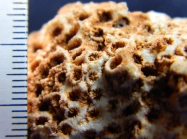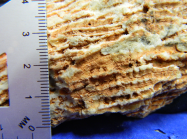Scleractinia name details
Cellulastraea Blanckenhorn, 1890 †
1581351 (urn:lsid:marinespecies.org:taxname:1581351)
unaccepted > junior subjective synonym
Genus
Cellulastraea crenata Blanckenhorn, 1890 † (type by original designation)
- Species Cellulastraea crenata Blanckenhorn, 1890 † (uncertain > unassessed)
marine, fresh, terrestrial
fossil only
Not documented
Hoeksema, B. W.; Cairns, S. (2024). World List of Scleractinia. Cellulastraea Blanckenhorn, 1890 †. Accessed at: https://marinespecies.org/scleractinia/aphia.php?p=taxdetails&id=1581351 on 2024-10-15
Date
action
by
basis of record
Cairns, S.D., R. Baron-Szabo, A.F. Budd, B. Lathuilière, E. Roniewicz, J. Stolarski & K.G. Johnson. (2010). Corallosphere. , available online at http://www.corallosphere.org [details]
 Present
Present  Inaccurate
Inaccurate  Introduced: alien
Introduced: alien  Containing type locality
Containing type locality
From editor or global species database
Remark The systematic position of the genus Cellulastraea Blanckenhorn, 1890, has long been discussed. Because of the presence of closely packed long individual corallites, it was believed to be a plocoid colony, belonging to the faviids or stylinids. Recently, it was grouped as a junior synonym of the genus Stylina (Löser et al., 2013, p. 11). Like Blanckenhorn himself, Felix (1913, p. 106-110) was of the opinion that this genus showed close affinities to forms of the Cyphastrea-Solenastrea-group. Vaughan and Wells (1943, p. 174) interpreted it to be a junior synonym of Solenastrea, and Wells (1956, p. F405) grouped it with Montastraea. However, investigations carried out by the author of the current work in 2013 revealed that by its thecal developments, Cellulastraea shows close affinities to the genus Cladophyllia Milne Edwards and Haime. Felix (1913) already pointed out such similarities, specifically referring to thecal developments seen in Cladophyllia articulata (Michelin). Because the holotype of the type species of Cellulastraea (C. crenata) is characterized by: 1) closely packed corallites in branching-phaceloid to subfasciculate integration; 2) has frequently but temporarily fused walls or is connected by exothecal developments (as seen e.g., in C. minor L. Beauvais, C. conybearei Milne Edwards and Haime, and the type material of the type species of the genus Cladophyllia [C. dichotoma]); 3) has compact septa that have small and sharply pointed granulae; 4) shows tabulate endothecal dissepiments in the corallite center and seem to have large vesicular ones in the peripheral areas; 5) has a mainly styliform to sublamellar columella (not mentioned by Blanckenhorn); 6) shows polyps in the process of septal division by fusion of opposite septa (typical of Cladophyllia; absent in Stylina); and 7) bears thecal developments which correspond to the type species of the genus Cladophyllia, C. dichotoma, the genus Cellulastraea is considered synonymous with Cladophyllia (Baron-Szabo, in press). [details]


